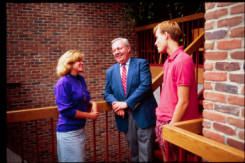
George Brushaber
George Brushaber left a lasting impression on the community of Bethel University. Brushaber served the community in many aspects but the highest of offices he held was President of Bethel University.
His story started with a frantic phone call from the presiding president, Carl Lundquist. This phone call resulted in Brushaber taking a last minute flight to meet with the Baptist General Conference in Seattle. This meeting then led to the eventual hiring of George Brushaber as the dean of students at Bethel University. Before accepting the job offer Brushaber had two questions of Bethel University:
- Was Bethel friendly to the sciences?
- And was Bethel supportive of the visual arts?
Brushaber accepted in the Fall of 1975. One of his biggest accomplishments as dean was growing the enrollment rate. He achieved this by looking at each academic department and improving each to be more suitable for the student. His biggest area of improvement was that of the science department. He served in this role for 7 years.
The transition from dean to the president did have some controversy, this being the idea that under a new president, changes would come into effect that would disrupt the unity that President Lundquist established during his presidency. The Clarion quoted Brushaber as “I don’t think people should expect any major changes in any of the programs and policies of the school in abrupt and dramatic fashion.” The Clarion then goes on to explain that Brushaber goals were to “help Bethel faculty, staff and students maximize their potential and coordinate the complexity that arises when a college and seminary attempt to work together.”
Brushaber became president after the retirement of Carl Lundquist in 1982. In his role as president of Bethel Univesity, he improved many areas of the University. These included….
- Establishing a Graduate School.
- He grew the enrollment rate from 1,467 undergraduate and 294 seminary students in 1975 to more than 6,000 students in all four schools in the 2006-2007 school year.
- 19 new buildings or enhancements were added to the Bethel University Campus.
- Bethel Univesity was ranked the 3rd largest private college in Minnesota.
- Bethel University Seminary was ranked the 10th largest seminary program of 250 accredited seminary programs.

Brushaber with Students
It was said that Brushaber would start his days as early as 7 am and continue beyond 6 pm each night. This shows how dedicated Brushaber was to the success and development of Bethel University.

Building of Benson Great Hall
Brushaber was not always seen without conflict. In one recent occurrence, the controversy was brought about with the construction of the Carl H. Lundquist Community Life Center which included the costly Benson Great Hall. Some deemed this grand building was not necessary. Besides the controversy, the Benson Great Hall was built and is now regarded as one of the top music halls in the upper midwest.
In “The Transforming Talents and Tenure of George K. Brushaber” Brushaber can be described as many things:
- Patient Candidate (Interview process with the BGC)
- Growth Generator (as stated above)
- Steady Visionary: He had a very detailed view of what he wanted Bethel to be seen as physically but also for academic success.
- Keeper of Mission: Brushaber continued to advocate for strong Christian values throughout his career at Bethel University.
- Energetic Scholar: As president, he came in with grand knowledge about many fields of study with excitement about each area as well.
- Inspiring Fundraiser: He captivated donors in ways that made them feel valuable.
- Networking Editor: He searched high and low for those who would make Bethel a better place.
- A friend of Students
- Reconciler
- Renaissance Retiree
George Brushbaer retired after a total 33 years serving at Bethel University, he turned role over to Jay Barnes in 2008